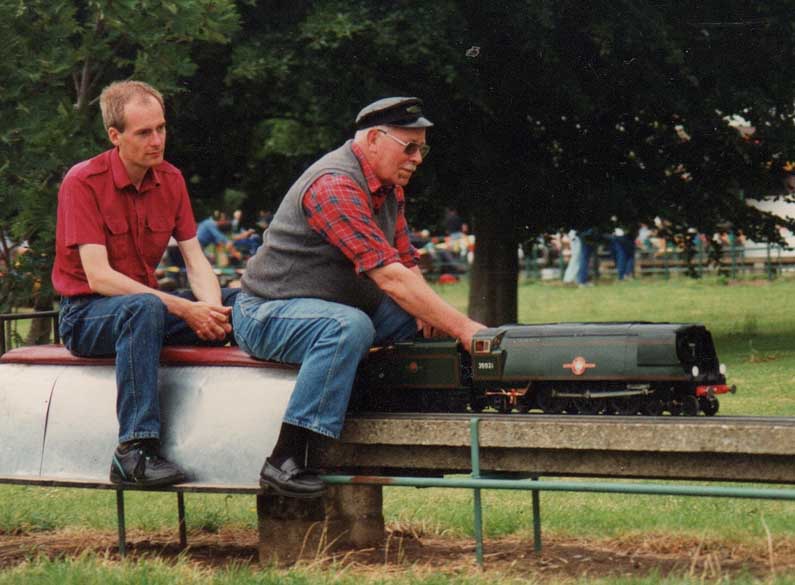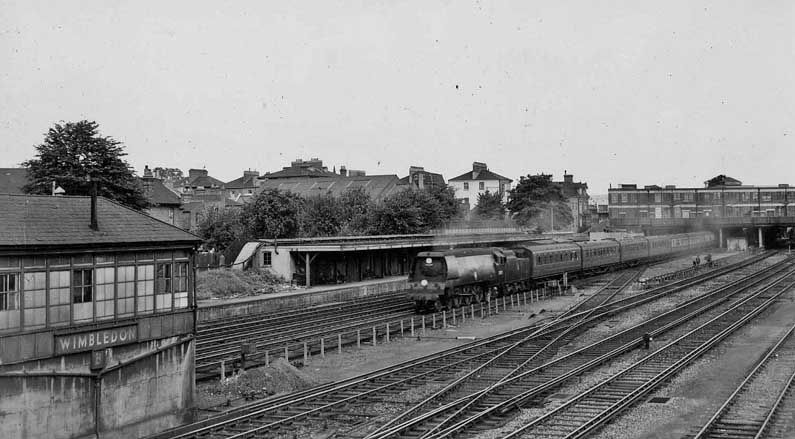
|
STEAM FROM WATERLOO Here is an appraisal of an interesting letter written by Russell Coffin to the author of the above book, Colonel H. C. B. Rogers, OBE. - Introduced by Jim Lester. Whilst Im sure many of you will have enjoyed the series of photographs on the Nine Elms website that were taken by Russell Coffin in the late 1940's, covering a lot of the Locomotive Exchange Trials and shots around Nine Elms and Waterloo. Indeed I'm equally sure that this fascinating letter will provide some depth of the character of Russell, who clearly was extremely interested in the finer workings of locomotives and actually built a miniature 'Merchant Navy' in 3.1/2 inch gauge (with chain driven valve gear).
Russell points out that the 'Nelsons' never really lived up to expectations and considers a three cylinder engine version would have been a better option. Clearly he much favoured the Bulleid locomotives and a comment on the exchange trials says everything! At the end of the day it was his point of view, as seen from his experience on the footplate! Even to those of us that still remain from the Nine Elms days the crew names mentioned in his letter, and indeed in the many captions on his photographs, will not be familiar to many such is the seniority gap that exists. Whatever I know that Russell quite rightly had a great regard for these men, real 'Southern Enginemen'! Fortunately a number of these men will feature in the continuing series of Russell's photographs (click here for the Russell Coffin Collection), thereby we shall be able to record their indelible contribution to the history of Nine Elms depot. Jim Lester 70A
28th July 1985 'STEAM FROM WATERLOO' - Colonel H. C. B. Rogers, OBE
Dear Sir, Why Jim Marsh thought I was a controversial individual I have no idea maybe it was because I liked to find out about things mechanical and so was better informed than some of my contemporaries. But all that was many years ago, and I only have a few months to go before retirement from the job of driving electric trains on the Central Division of the Southern Region, my depot being at Selhurst. Like Jim Marsh, I hated having to move from steam traction but the change had to be faced so I chose to go on the Brighton line, even though I usually got on any light pacific's that were being rostered, the foreman claiming that I was the only driver that understood them, and I eventually moved on to the 'juice' as steam began to run down. I remember Jim Marsh very well, a pleasant, conscientious worker. Now about the 'Nelson's, I agree with Jim's opinions about these fine looking engines. They never seemed to have the potential that their looks implied and I think that in a trial between a 'Castle' and a 'Scot' the 'Nelson' would not shine too brightly, while a 'West Country' in good fettle would run rings around them on the road! They did not often stray west of Salisbury and were not much liked ever by men at Salisbury or Exmouth Junction. Given a tender full of hard coal of a nice 'rubbley' size they would steam well, but a load of Welsh slack killed them pretty quick, and rough trip on a 'Nelson' was about the worst any fireman could have! Jim mentions the disposal of the engine off of the 'last Weymouth'. Ive some grim memories of this work too; one certainly had a gruelling task talk about developing your biceps no need to go to Charles Atlas for a course of bodybuilding. I fired 'Nelson's on this train many times, my mate and I relieving at Bournemouth Central. Most times the engine would run in with the blower on hard, steam pressure well down and a load of wet slack in the tender to see us through the next 108 miles! It was rarely a good trip and I can remember a terrible struggle with this train on one occasion. I was in the stages of developing influenza and the further we went the worse and weaker I became, till I could barely lift the shovel let only fire the engine. No help was forthcoming from the driver so we eventually scraped into Waterloo on 120lbs pressure and the water bobbing in the bottom nut of the gauge glass. Not a happy day! Jim mentions the 'Nelson's ability to throw sparks, well I have seen flames at the chimney top. My mate and I relieved on a long train of loaded milk tanks at Salisbury one night. The fireman that I relived told me that there was a load of Polish coal on the tender, all of it about the size of a matchbox. The engine was LN No. 30859 ('Lord Hood') and after we got the train on the move I think the guard said it was about 800 tons I was amazed to see blue flames coming out of the chimney as we passed through Fisherton Tunnel and this continued all the way to Amesbury Junction, where Jack eased her back a bit and the flames subsided. The coal must have been a bit gassy, it burned like household coal and kept me busy all the way to Clapham Junction where we left the tanks and went light to Nine Elms. I never saw this phenomenon again! Although the 'Nelson's had a good reputation for mechanical reliability, I experienced a number of failures, and had to come off the train with a big end failure, hot coupled axle-boxes, inside right combination lever pin and collar sheared off as well as having both injectors fail. Not all at the same time fortunately! I often wonder if they had had three cylinders like the 'Schools' class (and 'Royal Scots') and 250lbs pressure they might have been an outstanding loco, but I suspect that the boiler proportions were not quite right. Oddly enough those men that fired to LN No. 857 ('Lord Howe') with experimental round top firebox always said that this engine always steamed that much better than the rest. This was before my time in the railway service. Now about the 'Bulleid' pacifics before their conversion. In general I found these to be powerful, free steaming and fast, free running locomotives. I am also aware that they had features that were troublesome to maintain so must keep a balanced view of them. I have written an article giving the view from the footplate angle which may be published soon so will not go into too much detail here. Being a mechanically minded fellow I soon got the measure of their little quirks and foibles, both as a driver and a fireman, for on these engines you had to be the master or else sometimes they would get the upper hand! One or two points from your book need a little comment. In 'Steam from Waterloo' page 105, reference is made to re-coaling these engines at Bournemouth. This was not a regular practise as far as Nine Elms duties were concerned, I only had to do this once, not because of running out of coal, but running out of time! On the day in question my mate Fred Batho and I were working the 'Bournemouth Belle', when there was a complete failure of the pneumatic signals between Sturt Lane Junction and Basingstoke due to fractured air main, which caused us a 40 minutes late arrival at Bournemouth Central. So instead of going round to the West and then into Branksome loco to trim the coal forward, it was best to top up at the coal-stage at Bournemouth, then snatch our food, and back light to the West for a right time start for the up trip. Both the 08.30 and the 10.30 down to Bournemouth, and the 13.05 and the 15.05 back were worked by us and I never needed to take coal at Bournemouth on these trips. A trip on MN No. 35014 ('Nederland Line') with the coal weighing tender, hauling the 'Belle' at 480 tons gave a coal consumption of 37lbs per mile down and 41lbs per mile coming up, this was inclusive of coal used to build the fire up before leaving Bournemouth. Total consumption for the round trip was 4.1/4tons. So we had plenty of coal in the tender on arrival at Waterloo, it certainly never gave me any anxiety. Incidentally another fireman on the coal tests on No. 35014, with the same train returned a lower figure than I achieved! His name was Harry Vincent and he had been a stoker in the Royal Navy I believe, whilst yours truly had been a sergeant in the Royal Artillery in WW2. I can beat Jim Marsh's trip from Salisbury to Woking on a MN without picking up the shovel, for I have done it from Salisbury to Wimbledon before having to give the engine a sprinkle round the fire to get safely into Waterloo. The Exmouth Junction fireman had built up an enormous fire when I relieved him at Salisbury. I think the engine was MN No. 35025 ('Brocklebank Line'), a 'little clipper' according to the driver. I know the last 50 miles from Worting Junction is generally favourable to the engine but with the 'ACE' you cannot dawdle about! I reckon all the talk about extravagant coal consumption is only relative, bearing in mind the colossal waste at loco depots in general. While the 1948 loco exchanges showed the Bulleid engines to be slightly heavier on coal and water than other types, in most cases it was only marginal. My information is that the Southern crews were told to run the trains and not bother about coal, as the LMS were going to win anyway! Steam reversers are no novelty on a Southern engines, Drummond fitted them to nearly all his locomotives, while Ashford built locomotives had the pattern devised by Stirling. The latter pattern, designed to use only one operating lever instead of two was fitted to at least 20 MN's. I found it easy to use, but it gave problems to the heavy-handed or ham fisted who did not appreciate that it had two valves, one for slow movement and another for fast. On occasions I fired to a driver called Bert Thompson and it was delight to watch him use this reverser, adjusting the cut-off two or three per cent at a time no problem at all. This man was a superb driver ('engineman') of these locomotives and always handled them most economically as well as running the train to time. During most of my firing career I was lucky with the drivers to whom I was a regular mate, and had several who worked on a day and day about basis, that is driving and firing on alternate days. I learnt a hell of a lot that way. Of course once I got into the Top Link as a fireman the drivers were much older and not inclined to tackle any graft on the shovel. Fred Batho and I had MN No. 35021 ('New Zealand Line') as a regular engine, so we kept the footplate fittings all polished and the cab spotless. A real pleasure to go to work. Happy Days!
Hoping that all the foregoing has been of interest,
Yours faithfully
|
|
Site sponsored/maintained by SVSFilm © 2015 ... Go to SVS Film Index Go to Nine Elms Main Index - "Light to Loco" |

